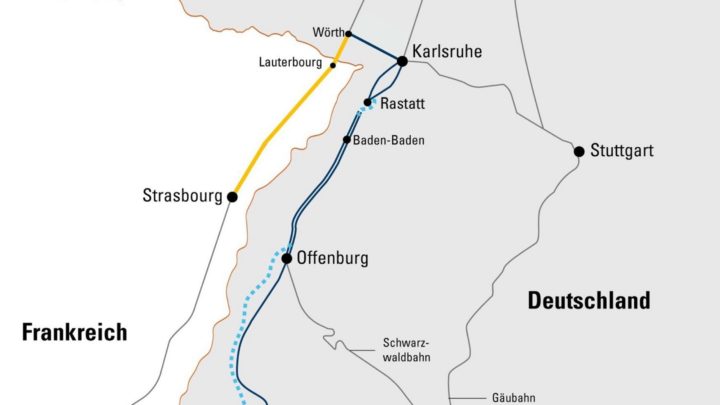
The completion of the Rhine Valley railway between Karlsruhe and Basel is not expected before 2040-2045. So, workable alternative solutions should be implemented before then, according to a briefing paper issued by the VAP association, BLS Cargo, Hupac, and SBB Cargo International.
The contractually agreed extension of the Rhine Valley railway as an element of the New Railway Link through the Alps (NRLA) concept is progressing slowly. The upgrade to four-track traffic, 740m train length and 2,000 tonnes train weight is intended to increase significantly the line capacity and performance.
The Swiss rail industry says it welcomes the infrastructure upgrade and expects it will be implemented quickly, as this will make a decisive contribution to achieving the modal shift and climate targets.
However, current capacity bottlenecks are noticeably worsening and represent a worrying constant.
Rastatt lessons
Construction sites, technical disruptions and insufficient diversion routes are putting such a strain on operations that regular freight transport operations are hardly possible any more, as was recently highlighted at a trade event ‘Five years after the Rastatt accident: still nothing learned?’
This has serious consequences for supply and modal shift, the industry grouping states. Already, shippers are showing a tendency to shift back to road, especially for time-sensitive goods.
“The Swiss railway industry is therefore calling for targeted measures to safeguard capacity and stabilise operations,” the paper says. “The main focus is on the railway line on the left bank of the Rhine, via France. Thanks to the flat route and good presuppositions with regard to its profile, it is an ideal complement and alternative to the Rhine Valley railway, on the right bank, via Germany.”
During the closure of Rastatt in 2017, it had already become clear that the Alsatian line could be used for the P400 profile thanks to the rapid coding of the Northern section Lauterbourg-Strasbourg and the technical inspection of the Southern section Strasbourg-Basel. Also, the upgrade of the ‘Gäubahn’ line between Stuttgart and Singen contributes to traffic decongestion.
Recommended targeted measures
The group proposes a number of measures. First a rapid upgrade of the Wörth-Lauterbourg-Strasbourg line.
The modernisation of the north-south axis on the left bank of the Rhine is currently one of the most important prerequisites for the stable use of the NRLA and for the further shift of transalpine freight traffic in anticipation of the full upgrade of the route on the right bank of the Rhine.
With motion 20.3003 on the conclusion of an international treaty for the expansion of the line on the left bank of the Rhine and motion 22.3000 on the financing of the electrification of the Wörth-Strasbourg line, the Swiss parliament has paved the way for Switzerland’s active participation in the expansion of the North-South corridor on the French side as well. This will create a parallel diversion route that will put an end to the construction chaos and ensure both transit and import/export traffic, which is important for the Swiss economy, the paper notes.
“The Swiss authorities should now press ahead with negotiations with neighbouring countries to achieve electrification and upgrading of the Wörth-Strasbourg line as an alternative route as soon as possible. With relatively little funding, an additional capacity of 60 freight trains a day can be attained within a few years,” the industry group says.
Access to diversion routes
Second, facilitate access to diversion routes via France. Further extensive construction work is planned on the Rhine valley railway, for example in summer 2024 with a four-week total closure. The diversion route on the left bank of the Rhine via France is passable, but only with disproportionately high operational effort and only for a small number of trains per day.
In order to avoid a renewed capacity crisis, access to the diversion routes must be facilitated. Temporary solutions should be found so that German-speaking train drivers can travel via France, for example by setting up German-French communication with linguistic apps or bilingual staff at the infrastructure control centres. The procedures for obtaining the necessary line knowledge should also be temporarily simplified.
Left bank
An internationally co-ordinated train path management on the left bank of the Rhine is also of central importance. Infrastructure managers in Germany, France and Switzerland should draw up a joint catalogue of continuous train paths, in order to let as many freight trains as possible run through this bottleneck in a stable and fluid manner. Capacity can already be noticeably increased by simply lifting the restrictions on night rail traffic.
Third, corridor renovation Germany. Rail freight traffic should be operated without interruption on the main international routes, the group asserts. Therefore, prior to line closures, infrastructure managers must ensure that there are no open construction sites, that facilities are problem-free and that the necessary equipment – overhead line, train length, storage areas, etc – is available for all trains using the alternative routes.
“It is in Switzerland’s interest that the general renewal of congested rail corridors, as announced in Germany, includes effective bypass concepts from the very beginning. Before completely renewing the bypass routes, they must be adapted to operational and infrastructure requirements,” the paper continues.
International cooperation needed
Fourth, infrastructure managers of the Rhine-Alpine corridor should be at one table.
The challenges in freight transport on the Rhine-Alpine corridor can only be mastered through international co-operation. The coming years of intensive construction activity are crucial in order not to jeopardise the attained success of modal shift.
“We propose the establishment of an international working body of infrastructure managers along the corridor with the involvement of transport ministries,” the paper says. “The aim is an active co-ordination of the requirements of the infrastructure extension on the one hand and a marketable transport offer on the other. As a central transit country in the Rhine-Alpine corridor, Switzerland is predestined to play a driving role in the implementation of the aforementioned measures. In this way, we will jointly ensure that NRLA meets expectations and that the shift from road to rail can progress continuously.”
